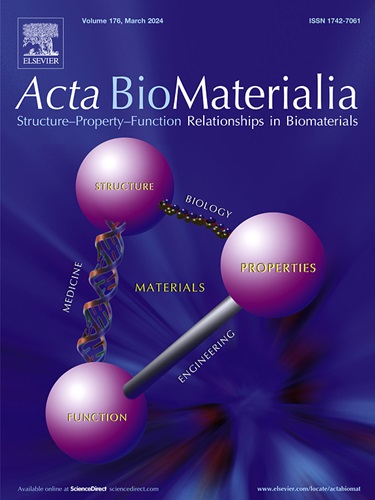Bovine amniotic membrane with antioxidant and anti-inflammatory properties for the repair of alkali-burned corneas
IF 9.4
1区 医学
Q1 ENGINEERING, BIOMEDICAL
引用次数: 0
Abstract
Corneal alkali burns are a common ocular emergency that can lead to blindness, marked by inflammation and delayed epithelial healing due to elevated oxidative stress in the intraocular environment. Mitigating the levels of reactive oxygen species (ROS) and the inflammatory response is essential for developing corneal repair materials. Amniotic membrane (AM) is frequently employed for ocular surface repair but faces limitations such as limited availability and rapid degradation. This study developed a crosslinked decellularized bovine amniotic membrane (CAM) with high transparency, enhanced mechanical strength, and enzyme resistance. By introducing Manganese-based carbon dots (Mn CDs), the composite (CDs@CAM) retained the physical properties of CAM meanwhile brought in the multi-enzyme activities of Mn CDs. Extensive characterizations demonstrated CDs@CAM high CAT-like activity, SOD-like activity and scavenging ability of hydroxyl radical and nitrogen radical. Furthermore, cellular and animal experiments demonstrated that the CDs@CAM possessed good biocompatibility, strong antioxidant capabilities, and anti-inflammatory effects, and thus significantly promoted corneal epithelial regeneration, inhibited neovascularization, and prevented scarring in alkali burn repair. This study offers a feasible strategy for artificial corneas and corneal disease treatment.
Statement of Significance
In this study, we developed a crosslinked decellularized bovine amniotic membrane (CAM) integrated with manganese-based carbon dots (Mn CDs), creating a composite material (CDs@CAM) that addressed the issue of high oxidative stress and severe inflammation in the eye caused by corneal alkali burns. Different from the conventional amniotic membrane products, CDs@CAM retains advantageous physical properties and biocompatibility of CAM while offering potent antioxidant and anti-inflammatory capabilities. We confirmed its good biocompatibility, as well as reductions in intracellular ROS levels and inflammatory responses. Importantly, in an alkali-burned cornea model, we revealed its outstanding performance in promoting corneal epithelial repair, inhibiting neovascularization, and thus preventing scarring, restoring corneal thickness and clarity to normal levels.

具有抗氧化和抗炎特性的牛羊膜修复碱烧伤角膜。
角膜碱烧伤是一种常见的眼部急症,可导致失明,其特征是眼内环境中氧化应激升高导致炎症和上皮愈合延迟。降低活性氧(ROS)水平和炎症反应对于开发角膜修复材料至关重要。羊膜(AM)常用于眼表修复,但存在可用性有限、降解快等局限性。本研究开发了一种交联脱细胞牛羊膜(CAM),具有高透明度,增强机械强度和酶抗性。通过引入锰基碳点(Mn CDs),复合材料(CDs@CAM)保留了CAM的物理性质,同时引入了Mn CDs的多酶活性。广泛的表征表明CDs@CAM具有较高的cat样活性,sod样活性和清除羟基自由基和氮自由基的能力。此外,细胞和动物实验表明CDs@CAM具有良好的生物相容性、较强的抗氧化能力和抗炎作用,从而在碱烧伤修复中显著促进角膜上皮再生、抑制新生血管形成、防止瘢痕形成。本研究为人工角膜及角膜疾病的治疗提供了一种可行的策略。意义声明:在这项研究中,我们开发了一种交联脱细胞牛羊膜(CAM)与锰基碳点(Mn CDs)结合,创造了一种复合材料(CDs@CAM),解决了角膜碱烧伤引起的高氧化应激和严重炎症的问题。与传统的羊膜产品不同,CDs@CAM保留了CAM优越的物理特性和生物相容性,同时提供了强大的抗氧化和抗炎能力。我们证实了其良好的生物相容性,以及细胞内ROS水平和炎症反应的降低。重要的是,在碱烧伤角膜模型中,我们发现其在促进角膜上皮修复,抑制新生血管形成,从而防止瘢痕形成,使角膜厚度和清晰度恢复到正常水平方面具有出色的性能。
本文章由计算机程序翻译,如有差异,请以英文原文为准。
求助全文
约1分钟内获得全文
求助全文
来源期刊

Acta Biomaterialia
工程技术-材料科学:生物材料
CiteScore
16.80
自引率
3.10%
发文量
776
审稿时长
30 days
期刊介绍:
Acta Biomaterialia is a monthly peer-reviewed scientific journal published by Elsevier. The journal was established in January 2005. The editor-in-chief is W.R. Wagner (University of Pittsburgh). The journal covers research in biomaterials science, including the interrelationship of biomaterial structure and function from macroscale to nanoscale. Topical coverage includes biomedical and biocompatible materials.
 求助内容:
求助内容: 应助结果提醒方式:
应助结果提醒方式:


